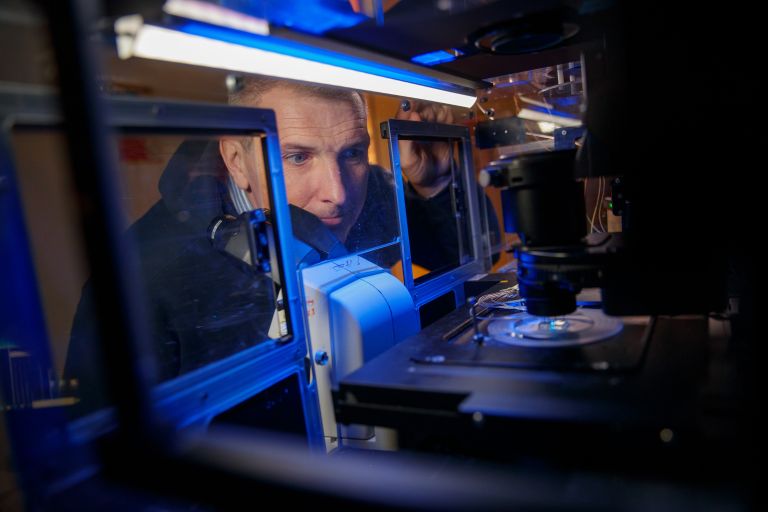
Johan Elf
Professor of Physical Biology
Wallenberg Scholar
Institution:
Uppsala University
Research field:
Mapping biochemical processes in living cells


Wallenberg Scholar
Institution:
Uppsala University
Research field:
Mapping biochemical processes in living cells
The structure of the DNA double helix has been known since the mid-1950s. The way the base pairs A, C, T, and G bind to each other is often depicted in a simplified form where the helix is extended and easily accessible. In reality, our DNA is tightly compacted into chromosomes to fit in the cell.
Elf, who is a Wallenberg Scholar, is developing new methods to study the structure of chromosomes during the cell’s lifecycle.
“We know a lot about gene regulation, but very little about how this process is influenced by the three-dimensional structure and movements of the chromosome,” he says.
“Our goal is to create a dynamic picture of how the chromosome folds during the cell cycle to learn more about how the structure affects gene functions.”
To this end, Elf’s research team is using one of the most popular and widely used bacteria in research: E. coli. The advantages of this bacterium include its rapid growth in laboratory environments and well-documented genetics. And it has only one chromosome, making it an excellent study object.
Every time a cell divides, the entire DNA molecule is copied so that the newly formed cells receive a complete set of genetic material. While copying is in progress, the DNA is also used as a blueprint to produce proteins in the cell. This means constant, intense activity around the cell’s chromosomes.
“To date, we have lacked effective tools to study the structure and dynamics of chromosomes in living cells. We are therefore developing completely new methods for this purpose. Once we have something that works well, we can map the impact on gene functions,” says Elf.
Most of his research is devoted to developing experimental techniques. The challenges are many, so the team includes a wide range of experts. Physicists, engineers, computer scientists, molecular biologists, mathematicians, and microbiologists are working together to develop new methods.
Advancements in fluorescence microscopy have enabled Elf to make several notable discoveries. One of them is how the molecules that regulate gene functions find their way so quickly among millions of alternative base pairs.
Methods to map chromosomal structure are now being developed. First, bacteria are grown in special microfluidic chips. The bacteria have minute markers at different locations on their chromosomes. These markers can then be tracked using advanced optical microscopes at nanometer-scale resolution and over periods ranging from milliseconds to hours.
Markers of various colors are added and the distances between them measured, yielding a detailed picture of how chromosomes move during the cell’s lifecycle.
The measurements are made in individual cells, allowing for mapping of biological variation between them. The measurements from the microscopes are collected as images and videos for comparison.
“One thing we want to understand is how the structure determines which genes are turned on or off at different times.”
Uncertainty is not our enemy – it is an inherent trait of both expectations and measurements, ready to be quantified and understood.
The microscope images are analyzed using a combination of new AI methods to observe movements in three dimensions.
“It’s a plus that the team possesses all the necessary expertise – from building the microscopes to developing image analysis.”
The technological developments required for basic research can sometimes have unexpected applications. Advancements in microfluidics and image analysis have laid the foundation for a company that develops antibiotic tests. The test can determine which antibiotic works best for a specific infection in record time.
“When we are able to delve into the most biologically interesting questions, it can often bring benefits in other areas. In the case of antibiotic resistance, it led us to start our own company.”
That company now sells an antibiotic susceptibility test for urinary tract infections, reducing response time from two days to just half an hour. The technology is now being further developed for tuberculosis. Many strains of the tuberculosis bacterium are resistant to antibiotics, often requiring a combination of several antibiotics.
To succeed in developing the new test, part of Elf’s lab is now being modified to meet higher safety standards.
“It currently takes about two weeks to identify the right antibiotic for tuberculosis. We hope our technology will reduce that time to about twelve hours.”
For Elf, pursuing a research career was a natural choice. Problem-solving is his fundamental driver, and at the university, it was easy to find new problems to tackle.
“Investigating how a biological mechanism works is one kind of problem-solving. Another is developing a measuring method to answer specific questions. In natural sciences, there are many paths forward, and in basic research, we have the freedom to use the entire toolbox.”
Text Magnus Trogen Pahlén
Translation Maxwell Arding
Photo Magnus Bergström